Typical Case -Rail Transit——Passenger Information System-PIS

MRD™子午线®—Features of Passenger Information System
1. Vehicle terminal equipments in PIS connect the vehicle industrial switches of each vehicle through network cables.
2. Each subway train of vehicle backbone network have one industrial switch, and form the redundant network by crossover cables. redundant switching time is no more than 50ms.
3. Vehicle backbone network must be constituted by switches with high MTBF and high LifeTime. Usually adopt the device with M12 interfaces and high IP protection.
4. Head/rear industrial switch of PIS backbone network must have functions such as layer-3 routing, NAT.
MRD™子午线®— PIS
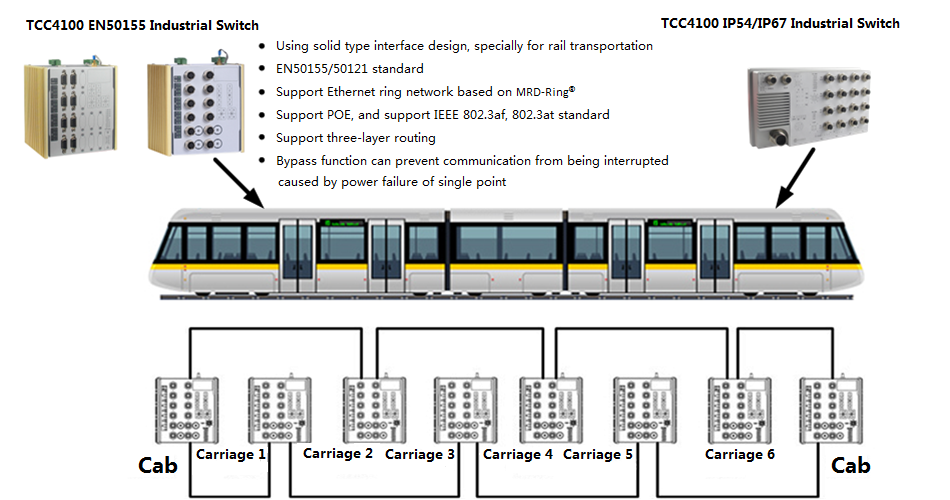
Typical Network—Shanghai Line 10
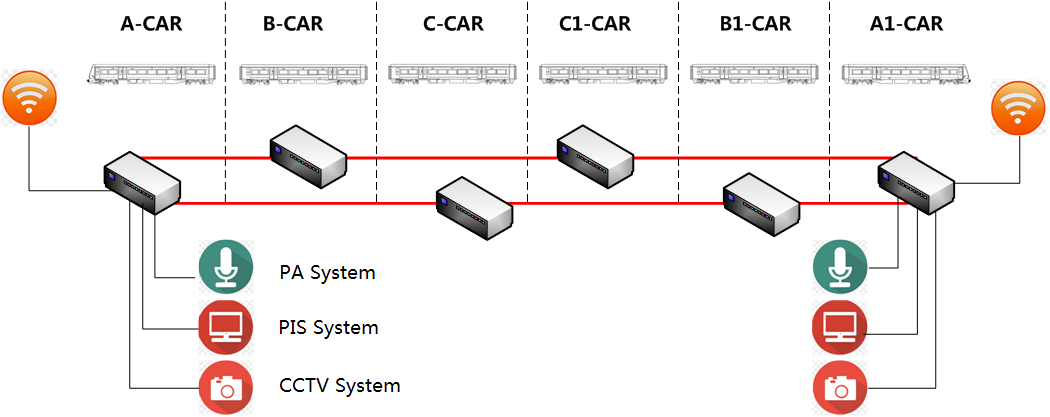
Analysis of Classical Network
In 2007, the first rail transit network has already adopted industrial Ethernet network. The network structure was ring topology. The self-healing time of the ring network was less than 50ms.
Adopt standard Ethernet cable as the jumper cable, because there will be some problems such as reflection radius and jumper cable connecter is unstable when using the fiber to connect the vehicle. The transmission distance of the standard cable is no more than 100m, so jumping-car connection method will be used to compose the self-healing ring network.
Industrial switches in the front/ rear of the car should be equipped with three-layer routing function and support NAT.
The Problem of Classic Vehicle Jumper-connection Network Structure
The connection of the vehicle is jumper connection. The carriages need to be organized into a specific group when reorganize the train otherwise the carriages except the front/tail carriage of the car can not be combined at random.
IP address of the network equipments are fixed. And it needs to be reset when changing the car or network equipment.
IP address of the terminal equipments are fixed. It needs manual help to reconfigure when changing the terminal equipment.
Too many jumper cables, and the connection is complex, the post operation and maintenance is hard.
MRD™子午线®—Ethernet Train Backbone (ETB)
IEC61375-2-5
IEC (International Electro-technical Commission) issued IEC61375-2-5 as the train communication network standard based on industrial switch. It meets the requirements of train communication network and also retains the advantages of the industrial Ethernet such as fast communication speed, high bandwidth, strong compatibility at the same time to realize the openness and interoperability between different systems and devices.
IEC61375-2-5 defined ETB(Ethernet Train Backbone), and specifically defined TTDP(Train Topology Discovery Protocol) to initialize the train network. It also detailed defined and described the data structure, redundancy mechanism, naming rule, quality of network service, data classification and other content of train network.
ETB mainly reflects the following characteristics:
The train network has a network redundancy system. When the network communication is failed, it will have a hot standby system to replace the operation to ensure the normal operation of the network.
The Train supports dynamic organization. It will automatically finish the organization after each time system power on. the car linked to hang and hang will not affect the normal operation of the train. The hitching and separating of the carriages will not affect the normal operation of the train.
Topological Structure
IEC61375-2-5 sets that the train network need to adopt linear topological structure. The front and rear nodes only have one way neighbor. All the direction of intermediate nodes have adjacent nodes. The data communication of the train network can only be done between adjacent nodes.
The protocol sets that the two reference directions respectively point to the front and rear. To guarantee the correct sending and receiving of the data, all the nodes in backbone network should keep the same directionality of the data transmission.

Hierarchical NetworkTopological Structure
The train network can be divided into 3 levels according to the structure: train level, carriage level and terminal level.
Train level network connect different carriages together through backbone network nodes—ETB.
Carriage level network connect devices on the same carriage by ECN defined by IEC61375-3-4.
Terminal level network realize the connection of different terminal devices.
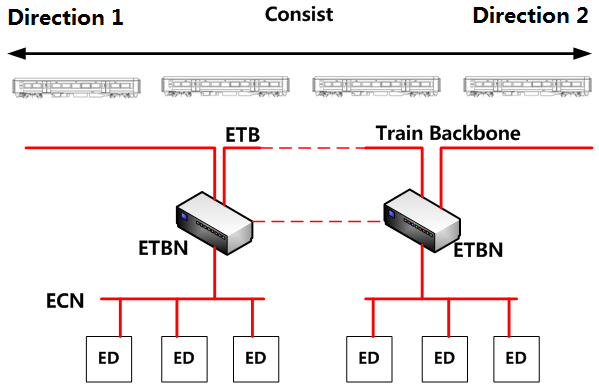
TTDP
IEC61375-2-5 specifically defined TTDP(Train Topology Discovery Protocol) to initialize the train network. The initialization includes the configuration to all nodes in the train network. And this protocol will be run after each time power on.
The aim of TTDP is to create an ordered table with direction, so it must be established based on that the backbone network should be linearly topological structure.
The main task of TTDP is to calculate the identification number of all the subnet on the train network and the identification number of all nodes on a backbone network. Establish the routing definition, network address translation rules and IP mapping and terminal equipment naming of the whole train network through these two representations.
The main process of TTDP running is as following:
The network keep running TTDP process, and each backbone network transmits data frame through multicast mode.
Declare your their own topology discovery information to the train network and access the networking topology information.
After get the networking topology information, establish the IP mapping of train backbone network node through logical topology, finish the update of network service such as DHCP.DNS.NTP, and annunciate the information of terminal device to the newly discovered node at the same time.
Data Classification
IEC61375-2-5 protocol defined 5 types of data, namely, monitoring data, process data, message data, streaming data, and best-effort data.
The monitoring data is used for the initial operation and complete monitoring of the train network and cannot be called by the application layer. It has the highest priority.
The process data is mainly used in management and monitoring of train. The longest waiting time is less than 20ms.
The typical use of message data is the management and monitoring of train, passenger information and report. The longest waiting time is less than 100ms. It is transmitted through unicast address and optional multicast address.
The streaming data is mainly used to transmit multimedia data such as video and audio data. Time delay is less than 125ms.
The best-effort data is used in upload and download configuration data or passenger data and environmental data. The typical use is FTP protocol or Network management protocol.
MRD™子午线®—Ethernet Train Backbone Network Industrial Switch
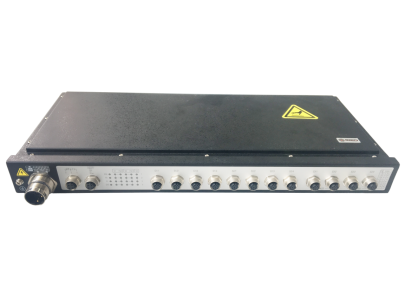
TCC4100 Train Backbone Network Industrial Switch
feature:
Self-healing time is less than 50ms High security redundant ring network
Support train backbone network protocol IEC61375-2-5 ETB
Support BYPASS High reliability and high redundancy
High IP grade IP54/67
MRD™子午线®——Product Stability:
1.MTBF—Mean time between failures
Based on SR-332 Algorithm
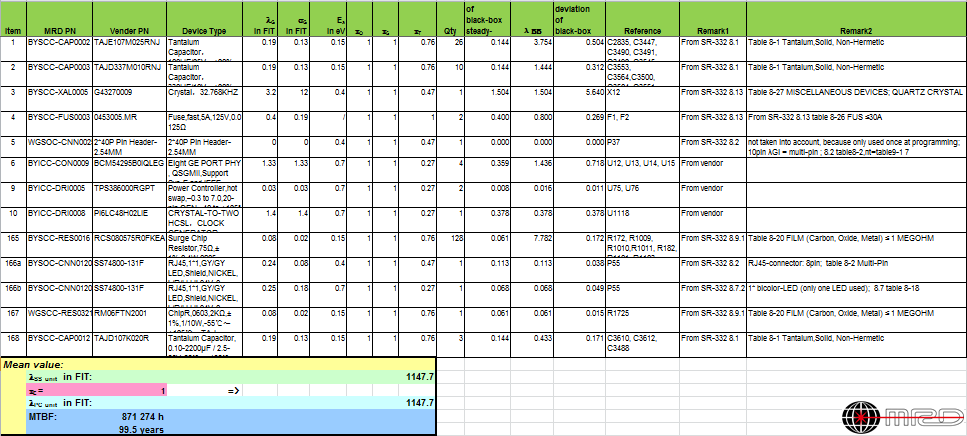
2.Lifetime—Average Lifetime
Based on the lowest operating parameters @ Operating Temperature Algorithm

3.Design—Details and experience of product design
The difference between air sucking and air blowing of the fan;
The difference between Conductive Oxidation and Spray Lacquer;
The difference between Immersion Gold and Tinplating;
The difference between single-port and multi-port of Network Transformer;
The difference between the lowest bottleneck of capacity and lifetime of electrolytic capacitor;
The difference between insulate and non-isolated power supply;
The difference of Software periodic memory check;







